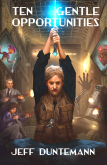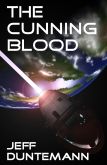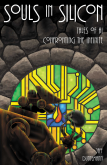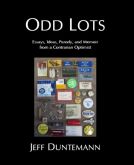- I know, I know, I’ve been quiet for a week, but there’s been a lot to do away from the keyboard, much of which borders on sock-drawer sorting. Focusing on only one project for most of a year almost guarantees that things will get messy away from the target of your focus. So I’ve been picking up downstairs in my workshop and sorting my office closet. No socks, but lots of loose fileables sitting in a pile, one with a yellowed corner that did not come with age. (So much for cacheing data on the floor.)
- We have a rattlin’ good sunspot creeping across old Sol’s face, and whaddaya know: I spun the dial across 15 meters this afternoon and heard voices. ‘Course, my fire alarm still does not like the Icom 736, so all I could do was listen, but it was nice to think of this overlong solar minimum as something other than eternal.
- If you haven’t already, upgrade to Firefox 3.5.6. There are a number of newly discovered exploits in earlier releases, including a remote code execution item that looks pretty ugly.
- I also upgraded to Thunderbird 3.0 earlier today, and so far am most pleased. They’ve added a profile-wide message search feature that (considering the appalling number of emails I’ve accumulated and carried forward since 1995) will be extremely useful here.
- Speaking of ugly, when a film with the budget and ambitions of The Avatar can only do aliens who look like ugly humans, you have to wonder what CGI is for. This is the problem I’ve always had with Trek: A splurch of latex on some extra’s forhead does not an alien make. I’ll see it anyway, but I call failure-of-imagination based on the trailers.
- InfoWorld posted a very nice review of the major virtualization products, including VMWare Workstation 7, Parallels Desktop 4, and Sun’s VirtualBox 3.1. VirtualBox is free and installed by default in Ubuntu 9.10, but you have to jump through some inexplicable hoops to get it to recognize USB devices. I haven’t upgraded to VMWare Workstation 7 yet, but Workstation 6 is cheap and does everything I need it to do.
- People argue a little about how useful certain time-honored degunking techniques are (especially disk defragmentation, and double especially defragmentation for SSDs) but the biggest single win in my own experience is degunking the Windows Registry. There are a number of apps to do this, but the best on the free side is doubtless CCleaner. (Its original name was Crap Cleaner, which gets points for truth-in-advertising.) Freeware, and if you’re ever faced with a Registry that’s been gathering crap for eight or ten years, you’ll appreciate what it can do.
- Two people wrote to me (a little breathlessly) to tell me that Neal Adams is drawing the next several PvP strips, and I had to admit that I had no idea whatsoever who he was. I flashed on Nick Adams, whom I saw on a few episodes of The Rebel back in 1961…but a comics guy I’m just not, even if I do follow PvP. (In case you’re as clueless as I, here’s a bio on Neal Adams.)
software
Odd Lots
Odd Lots
- We broke a new cold record for December 3 last night, when it went down to -3 here. (The previous record was +3, so that’s a significant margin.) Cheyenne Mountain is covered with snow, and it’s a wonderful wintry-Christmasy scene out my office windows, though I have to get out there and clear the walks when the temps eventually get up into double digits.
- My prediction: We will not quite break 2008’s record for sunspotless days this year. Why so sure? Well, we’re already at 255 days (and just passed 1912’s count of 253) but a sunspot appears to be forming on the back of the Sun, and it will rotate around the far side and come into view in about a week. If it’s a big enough spot, it may be visible for the rest of December. So add 7 to our current 255 and you get 262, which is in cigar territory for 2008’s 266 sunspotless days, but not quite lit. Of course, if the spot lives and dies over the next week or so (which I’ve seen happen for smallish spots) we may still beat 2008. Either way, we’re in the thick of the deepest solar minimum in 150 years.
- I just ordered a Dell Inspiron Mini 10 netbook, after spending some quality time with Julian Bucknall‘s slightly older and smaller Dell netbook at the Meetup-less Delphi Meetup last night. The keyboard is surprisingly usable, and I don’t expect to be writing any 180,000-word computer books on it. I was looking for compactness, not cheapness (there’s a larger toy budget this year, much thanks to Assembly Language Step By Step and other things) and so I loaded up with a GPS receiver, higher-res display, faster CPU, and (obviously) a bigger battery. All that, and it still runs XP. Windows 7 was an option, but why burden a pocket machine any more than it’s already burdened by just being a pocket machine?
- Intel has unveiled a novel 48-core x86 processor, arranged as 24 dual-core CPUs communicating through a mesh network with up to 256GB/s bandwidth. Cores no longer need hardware cache coherence machinery, which cuts the complexity and power consumption of the (huge: 567 mm2!) part. I’m still wondering howinhell we’re gonna program these things.
- Does anybody my age or older remember the TV series Men Into Space? It ran for one season in 1959-1960, and was created by Ziv TV, the firm that also did Science Fiction Theater, Sea Hunt, and Highway Patrol. Remarkably, I don’t remember it at all, even though Broderick Crawford’s iconic “10-4!” is crystal clear in my head. There was supposedly some Bonestell backdrop art in the show, and a solid attempt at factual accuracy, within the limits of weekly TV production of the time. Thanks to Roy Harvey for the link.
- People who are familiar with my novel The Cunning Blood should take a look at these 3-D renderings of the Mandelbulb. This is almost precisely what I had in mind when imagining Magic Mikey’s views of chaos signatures using the Femtoscope. (Chapter 12, p.196ff.)
- In a dance-around-it sort of way, Slate admits that there’s no compelling reason to use Office 2010…or 2007…or any version past the one that meets all your needs. Duhh.
- From Neil Rest comes a pointer to a puppet show dramatizing the Bohr-Einstein debates over spooky-action-at-a-distance. Einstein is played by a stuffed bichon. (What else? You’d cast a Chihuahua?) BTW, this is for real; it’s not a parody but an actual physics lesson.
- Borders is closing about 200 of its Waldenbooks mall stores in January. Here’s a PDF list of stores to be closed. I’ll admit that I haven’t bought anything at a Waldenbooks store for many years, simply because they don’t have the selection of the “big” Borders stores. (I also don’t go to shopping malls that often.) This may be good news, if it means that fewer of the big stores will have to go down too.
Think Before You Click!
I have a stray hour this morning, and I’d like to work in some notes on a few deceptive online mechanisms of various species that came to my attention all at pretty much the same time.
The first of these is Fanbox, which is a spinoff from a site called sms.ac a few years ago. I’m getting emails daily that claim to be from Facebook friends telling me that “Rodney Hornswoggle thinks you will really like this YouTube video. [Click here to] Check it out.” Even though I do know Rodney and he is on my friends list, a pitch like that smells to high heaven, and I’m not dumb enough to click on it. I researched it online and got a faceful. The emails were sent by something called Fanbox. Fanbox is a Facebook service that does various things, but, almost incredibly, it works by asking people for their email account and password, so that it can begin spamming everybody in the hapless users’ address books.
I boggle at the notion, but in fact this is not a new phenomenon. Fanbox’s corporate parent sms.ac has done this sort of thing for years, to the huge annoyance of a great many people. As with other things of this sort, the full story is complex. Google on “sms.ac scam” or “fanbox scam” and you’ll begin to get the idea. The takeaway here is obvious: Don’t give your email account password to Facebook apps. Or anybody else, for that matter. Geez.
Next is Video Professor, which is (again) not a new idea: Selling tutorial DVDs via “negative-response billing.” This is illegal in Canada but not the US, and hearkens back to the “book of the month” clubs or “record of the month” clubs in years past, in which you agree to accept (and pay for) an item every month until such time as you cancel the membership. At least with those ancient systems you had some reasonable idea of what it would cost you. Details of how much you end up paying Video Professor for a number of tutorial DVDs ($290!) are obscure, and present only in some very, very small print. TechCrunch’s Michael Arrington wrote about it in the Washington Post , after which Video Professor tried to intimidate both Arrington and the Post with legal threats. It didn’t work, and the effort spawned a great deal of negative publicity for Video Professor. However, they’re still out there, selling DVDs using what I consider an extremely deceptive pitch. Stay well back.
Finally, while we’re talking stuff-hidden-way-down-in-the-fine-print, there are “online loyalty programs.” (More here.) The scam works like this: An online retailer takes your credit card information during an order, but just before the order is completed, you’re invited to join a loyalty program to receive coupons or discounts or something. The program costs $9-$12 per month, but (as always) that’s way down there in the fine print, which authorizes the online retailer to give your credit card information to the loyalty program operator, who then bills your card and kicks backs funds to the online retailer that originated the lead. As with rebates, most of the coupons and other “rewards” are never redeemed, so it’s basically a free monthly slurp out of a great many credit card accounts. Online merchants who use such systems should be avoided. Here are a few mentioned in the article: Priceline (you’re old, Jim!), Orbitz (how d’ya think they could afford that hovercraft?), Buy.com, Fandango, 1-800-FLOWERS, Continental Airlines, and many others. (I printed out the full list included in the article as a guide to my personal boycott of anybody offering such programs.) And wow! Our old friend, Classmates.com, pocketed $70M through its partnerships with the loyalty progam operators.
Don’t be a victim. Think before you click. Read it all, especially on second or third-tier sites that you haven’t dealt with many times before. Check every line on your monthly credit card statements. Google for the name of the site and “scam” and see what others have said. Paranoia isn’t always a mental illness these days, especially online.
How Necessary Is Windows? Part 5: Crossover
There have been several attempts down the years to make Windows unnecessary. The most audacious is doubtless ReactOS, which cuts to the heart of things and wants to be a complete Windows XP-compatible OS. Needless to say, this is no small project and will take a long time to complete; right now, I’d call it somewhere between completely useless and intriguingly experimental. (It runs Skype, at least.) I’m also concerned that if they ever do get it anywhere near useful completion, Microsoft will stomp on it hard.
That’s certainly the high road. But how necessary is it to clone the whole damned OS? A Windows app, after all, is just a block of x86 machine code that makes calls into one or more APIs. If you can clone the APIs in an acceptably clean-room manner, you don’t need to duplicate the entire architecture, kernel and all.
And that brings us to one of the oldest and oddest ongoing projects in open-source computing: Wine, begun in 1993 by Bob Amstadt and Eric Youngdale. Wine provides a compatibility layer consisting of clean-room DLLs implementing the Win32 APIs, plus whatever magic is necessary to make the deeper host OS machinery look like Windows to the app. This is easier than implementing a whole OS, with the further advantage that if done properly, Wine can act as a Windows compatibility layer over several Unix-like OSes, rather than only Linux. Currently, Wine can operate over Linux, Mac OS X, FreeBSD Unix, and x86 Solaris.
After 16 years of dogged work, Wine actually works pretty well. Part of its success is due to a remarkable cooperation between the Wine project and a commercial software house in St. Paul named Codeweavers. Codeweavers sells a $40 deployment/management utility for Wine called Crossover, which basically makes Wine noob-friendly. (Naked Wine is pretty stark.) Codeweavers also tweaks Wine itself to improve app compatibility, and contributes those tweaks back to the Wine project under LGPL. Some financial support is also provided to the otherwise volunteer-based Wine project. Wine’s founder, Alexandre Julliard, is an employee of Codeweavers, where he works full-time on Wine development.
Codeweavers focuses mostly on big-market apps like Microsoft Office, and doesn’t officially support apps beyond a relatively short list of “gold” software. However, I’ve found that a great many Windows apps install and run just fine under Crossover whether they’re on the list or not. InDesign 2.0 is listed on the site as “known not to work” but apart from a minor display glitch, it seems to work as always. (I haven’t tested it deeply so far.) Most Microsoft apps work beautifully (especially older ones) and I’ve been using Office 2000 and Visio 2000 under it without incident since last fall.
Wine implements a sort of runtime environment emulation for Windows called a “bottle.” More than one bottle may be created on a single host OS, and each bottle has its own emulated C: drive and Registry. By giving each Windows app its own bottle under Wine, apps are prevented from interfering with one another in the dreaded “DLL Hell” effect. Because it’s not a VM, the performance hit for running Wine/Crossover is very small, and most important, you do not need to have a legal copy of Windows running in the VM. On the other hand, a bottle looks enough like Windows to be infectable by Windows malware, though one bottle probably can’t infect other bottles on a Linux system, or the underlying system itself. (From what I’ve heard, the low-level system tricks played by many malware packages keep them from running or at least running completely.) There are known conflicts between WGA and Wine, so don’t install WGA if you can avoid it.
Bottom line: If Wine supports all the Windows apps you absolutely must use, you do not need Windows at all. I haven’t tested all the Windows packages that I use here (next up is MapPoint 2004) but for Office and Visio 2000 it’s been nothing short of magical, and I’m guessing InDesign will come along eventually. In a mature software market, time works in our favor: One by one, existing apps will be installable under Wine, and each time that happens, Windows slips a little bit deeper beneath the waters of irrelevance.
Next up: For the hard cases, there’s always virtualization.
How Necessary Is Windows? Part 4: Format Lock-In
Computing certainly isn’t about operating systems. Nor is it really about apps. It’s about files. Data is what we create, modify, store, and distribute in electronic form, and the ways that our data is stored give shape to almost everything else we do in computing. Being able to move from one platform to another thus depends almost completely on whether or not we can bring our files with us.
I’ve been working in front of a personal computer on an almost daily basis since May of 1979, and over the past thirty years I’ve accumulated thousands of made-by-hand files. Much of that is text, and I’ve had almost complete success bringing document files forward down the years, bouncing from one word processor to another by using various format-conversion tools. SF stories I wrote in CP/M WordStar in 1980 have passed through WordPerfect for DOS and several major releases of Microsoft Word and still live on my writing projects thumb drive. I keep a commercial Windows utility called Quick View Plus on hand to extract text from extinct file formats when necessary, which has been pretty rarely in recent years. Still, it’s there if I need it.
It’s a lot tougher once you get away from text. There are no conversion utilities for Adobe InDesign or Microsoft Visio, and as best I know nothing will import files created on either app. This is probably also the case for QuickBooks, and probably a great many more major applications that I’ve simply had no need for and no experience with.
I don’t think it’s an exaggeration to say that this kind of file format lock-in is the only thing keeping some of these companies profitable, or for some of them simply in business. Computing is mature in terms of the basic mechanisms we use to manipulate data: text editing, page layout, spreadsheeting, presentation, raster drawing and vector drafting, image processing, and database query and display. Small points may be patentable, but the fundamental machinery is now older than any surviving patents. Building an app that could load and edit an InDesign layout file would take some work but no genius, and if done would be a major competitor to InDesign, not only in new projects but (crucially!) in existing projects as well. Adobe guards its file formats with its life because its file formats are its life.
Alas, my files are my life too. And when Adobe’s IP rights bump up against my IP rights, who wins? Adobe, of course. Hence my hatred of activation: I don’t use newer versions of InDesign because Adobe can turn them off remotely and basically hold my work hostage if they choose to, perhaps because they’re too stupid to tell a RAID from a separate machine, or because they’re hungry enough to want to force me to pay for an upgrade that may have no new features that I need…and maybe no new features at all.
I have no general Stallmanesque animus against commercial software. I have a fortune in boxed apps on the shelf, and have never minded paying for them, even when they were upgrades. However, upgrading must be my choice, and migration of software to newer machines as time passes must not require new licenses.
Even commercial software that doesn’t require activation often demands a service and a tray icon, constantly popping up notifiers trying to upsell me to something I neither want nor need. In a mature market, there’s less demand for upgrades, and people can be happy using software for a long, long time. I can understand the vendors’ perspective and their need to be selling all the time to stay alive in a mature market. I think they should recognize my right to find it annoying and turn to software that doesn’t yammer so much and waste my cycles.
The bottom line here is that some apps are difficult to move away from; for me, the two killers are InDesign and Visio. Yours may be different, but I think most people who do creative work at the keyboard have a few. The difficulty lies entirely in proprietary file formats, and leads me to the infuriating conclusion that Windows is necessary only to allow me access to my own files.
The good news (for small values of “good”) is that there are tricks to be played. More in the next installment.
How Necessary Is Windows? Part 3: Apps
I came down with a monster headcold the last couple of days, and whereas this entry was in the can since Sunday, the remaining entries may be a little slower in coming. Bear with me…
We don’t use Windows because it’s Windows. (Most of us use it because it came on the machine and, well, it’s paid for.) Windows is just an operating system, and an OS is a troll living under a bridge. Applications with specific missions lean over the railing and shout orders to the troll, who (mostly) does as they say while keeping order up on the bridge. An OS is 80% facilitator and 20% bodyguard. Our real work happens in the apps. If the apps we use can be run without Windows, then Windows isn’t necessary at all.
There are three ways to break free of an application’s dependence on Windows:
- Find a version of a Windows app that runs on your OS of choice;
- Switch to a similar app that runs on your OS of choice; or
- Coerce a Windows app to run somehow on the OS of your choice.
I’ve done all three, and for the sake of further discussion here, the OS of choice is Linux. Mac OS/X is another worthy option, and all three of these methods are available there too, but for several reasons I hesitate to give Apple my money. (We’ll talk of this at some point; people who know my deep history will understand.)
There is a lot of very good free software to be had for Linux, and it can be had very easily. The Ubuntu Software Center allows easy search for apps via category browsing or keyword search, and any selected apps are downloaded from trusted repositories and installed without further intervention. The Software Center can tell you what packages are already installed, and can uninstall packages you no longer want. This is so uncharacteristic of the ancient Unix culture of pain that I still giggle sometimes when I install something. (“This is easy. Too easy…”)
I was a little surprised at how many Windows apps have almost identical versions running under Linux. This is true of some commercial apps as well as free apps, but free apps are much more likely to have Linux versions. I use the following apps almost identically under both Windows and Linux:
- Firefox Web browser
- Thunderbird email client
- Skype VOIP/IM client
- Kompozer WYSIWYG HTML/CSS editor
This represents a good deal of what I do in front of the keyboard. (Maybe a third.) I’ve heard that Google Earth can be had in a Linux version but haven’t tested it yet. It’s not available through the Ubuntu Software Center.
Switching to a similar Linux app takes more doing, but for some sorts of work it isn’t difficult. I don’t use newsgroups very much anymore, but using Pan under Linux was relatively pain-free, even though it’s quite different from Forte Agent in many respects. There’s a very useful site called Open Source As Alternative that provides suggestions as to what free apps are reasonable alternatives to many commercial Windows apps. Definitely spend some time there if you haven’t already; the real trick in open source software is often just knowing that it exists, absent pervasive ad campaigns. For example, I’ve known about the Gimp for ten years, but never heard of GimpShop (Gimp reworked to have a menu structure more like Photoshop’s) until I read about it on OSAlt.
KOffice is probably the best of the open-source office suites, though not all the several apps are equally powerful or polished. OpenOffice is even better functionally, but it has some weirdnesses (font management first among them) that probably stem from its Java-centric design. It used to be the only one of the open source word processors I know of that will load a .docx file, but the latest Abiword will do that now. Note that OO will bog anything less muscular than a 2 GHz Pentium, so don’t install it on older machines, and max your memory before you install it on anything.
For generating raw text and editing old Word 2000 files, I now use Abiword routinely. I don’t do much spreadsheeting, but my fairly simple PlanetPlanner spreadsheet loads and runs on Gnumeric, and that’s good enough for me.
Alas, once you get away from the most simple and widespread categories of apps (like word processors and spreadsheets) the news is mostly bad. The real problem with similar-but-not-identical apps isn’t the work it takes to learn them. It’s a phenomenon called file format lock-in, and in some respects is the key issue in this discussion. More about that in the next installment, probably when my nose stops dripping into my keyboard.
Odd Lots
- There’s a useful overview of the latest Ubuntu release (9.10) here. Note the cautions about the 9.10 partitioner, especially if you have more than one SATA drive in a system destined for a clean install on a shared drive. I ran into some still-unresolved difficulties with the partitioner recently, but they seem to be machine-specific and may be due to BIOS limitations. More on that as I learn it.
- A similar site for Kubuntu 9.10 is here.
- I’m not much into costuming (or Halloween, for that matter; my sister got that gene instead) but within the genre of one-person-pretending-to-be-two, this may well be best-of-breed.
- On the other hand, this one comes close, for sheer attention to detail if nothing else.
- And while we’re talking tauntauns, didja see the tauntaun sleeping bag? Authentic right down to the tauntaun guts pattern on the lining. (Thanks to Pete Albrecht for the link.)
- 2009 is now #8 on the most-sunspotless-years-since-1849 hit parade. Ten more spotless days and we move into position #7. I’m laying odds that 2009 will eventually get into 6th place but no higher.
- God may not like the Higgs Boson, but hey, I’m not all that fond of opera. (Thanks to Pete Albrecht for the link.)
- Here’s an interesting pamphlet from 1945 on what the future of television might be. If they only knew…
- Frank Glover sent a link to an article sponsored by the ESA suggesting some SF ideas that have been realized to some extent or still may have some promise in our own (and not some alternative) future. A little breezy, but has a lot of full-color SF art and classic magazine covers. (5 MB PDF.)
- This may seem like a weird stunt, but it was (and may still be) a common thing on dairy farms. When I was 10 or 11, I watched Auntie Della milk a cow by hand one morning for the day’s needs, and the barn cats (who kept the barn free of mice) would line up for their milk squirts. Auntie Della’s aim was very good, and by all indications the cats were completely good with that.
- Make Magazine published a brilliant little project: A vacuum cleaner hose trap for small parts like screws and washers. (110K PDF.) Doesn’t rely on magnetism, but is more like a lobster trap, in that parts enter easily but can’t leave, and rattle around tellingly when the hose pulls them in.
- From the Jolly Pirate comes word of the Corsair Flash Voyager GT: A 128 GB thumb drive optimized for speed, and (according to him) capable of holding over 20,000 MP3s. $400 now…but check again in six months, heh.
- Turn the Dodge Viper logo upside-down, and what you’ve got is Daffy Duck.
How Necessary Is Windows? Part 2: Ubuntu
In the past two week’s I’ve installed Ubuntu Linux 9.10 (Karmic Koala) three times: twice as upgrades, and once as a clean install from a CD. The combo LiveCD/installer ISO came down with uTorrent in 8 minutes 5 seconds (!!) and has given me trouble only once, and that with the partitioner: I tried to install 9.10 on Carol’s old HP laptop, but the partitioner could not determine the size of the existing Windows partition, and thus the resizer slider would not appear. On an SX270 with a similar size hard drive and an existing XP partition, the partioner resized XP without any trouble. (I’m wondering if there’s some weirdness in the HP BIOS, but have not gone after it yet.) I’ve spent a great deal of time in Ubuntu in recent days, and beyond that one little glitch with the laptop, I’d say Karmic is the best one yet.
Apart from its contrarian (and purely optional) brownness, Karmic’s default GNOME desktop is a great deal like Windows XP. The taskbar functionality is divided between two panels, one at the top and one at the bottom. Now that 20″ displays are common, I use two lines for the Windows taskbar as well and don’t begrudge GNOME the extra line–and you can put both panels at the screen bottom if you want to. The Home folder stands well for My Documents, with familiar subfolders for documents, music, pictures, video, and downloads. Nautilus looks enough like Windows Explorer to pass, especially given that most of us custom-configure Explorer after awhile and not everyone’s configuration is identical. Left mouse button selects, right brings up context. In short, all the basic ideas of the Windows UI are present, in recognizable form. There’s some bumping-up-against-habit in switching from one UI to another, but after even a little time exploring in GNOME you won’t be lost anymore.
The Control Center is a great deal like Control Panel, with applets to manage most configurable options. One gripe about the Control Center is that there is a perfectly good applet to manage grub’s boot options, but it’s not installed by default and I only came across mention of it online by accident, while looking for something else. If you want it, go into the Software Center, and search for Startup-Manager. Install it, and you can specify grub’s default OS, the menu time delay, a splash background, and other things. I take back the grouchiness expressed in my entry for November 7, 2009, with the exception that Startup-Manager needs to be installed by default.
I still have a gripe with Linux generally that goes back a long ways: It needs centralized font management. Unless I’m missing it (and I looked pretty hard) no such applet exists for Control Center, and installing fonts is much more fussy than it needs to be. This may not matter much if you’re not a publisher or a graphic artist, but it matters a lot to me. I have a set of expensive Type 1 fonts that I bought in 2001 and use in all of my Copperwood Press books, but getting them into Linux was non-trivial, and not all apps that should recognize them do. Scribus and poor little Abiword picked them up immediately, but OpenOffice still can’t see them and I still can’t figure why. I know that X11 makes font management a little more complex than it is in Windows, but that’s no excuse for not having a font manager in Control Center.
Beyond that, few complaints. There is now a Safely Remove Drive context menu item for thumb drive mount icons that I don’t remember seeing in earlier versions. Videos that play without sound in Windows (due to obscure codec errors) play with full sound in Karmic. Bottom line: Ubuntu 9.10 implements all the fundamental GUI machinery that Windows does, and does it with enough similarity not to drive a newcomer to distraction. From that standpoint, Windows really isn’t necessary at all…but alas, GUI machinery is only one small piece of the larger Windows pie. More tomorrow.
How Necessary Is Windows? Part 1: Overview
Still dealing with neck problems here, but in the background I’ve been pursuing a long-term, low-intensity project aimed at discerning how necessary Windows is for my daily operations. Back in 2001 or so, Keith and I considered publishing a book called Dumping Microsoft, but after I looked closely at the Linux releases of the time, decided it would be premature. Windows 2000 was mighty good, and Linux had yet to break out of its all-hail-the-console, pain-is-good hacker culture. It may be time to reconsider the necessity of Windows (and perhaps that book) which is what my upcoming series here is about.
I’ve changed operating systems often enough in the last 30 years not to get too attached to any of them, and have no tribal/emotional investment in Windows 2000 or XP. An OS is just a workbench, after all: It does very little work by itself, and exists almost entirely to help applications do what they must do in the most productive way possible. Too much of modern OS versions is just gratuitous glitz, which eats machine cycles and doesn’t get a page laid out any faster. My reaction to Windows Vista was pretty simple: What’s in all this for me? The primary purpose of Windows Vista was to make itself harder to steal, which is something of a fetish over there–and all the glitz was tossed in to persuade people to upgrade. Furthermore, the damned thing was slow. No sale.
You’ve heard me say many times here that personal computing is mature. I help out people at our parish with their computers, and an astonishing number of them still use Office 97. They may use the latest IE or Firefox, but they haven’t seen the need to spend more money on word processing or spreadsheets. That’s because the need isn’t there. Office ’97 probably has 90% of everything useful in an office suite; if you want the rest, get Office 2000, which I myself have been using for almost ten years now.
It’s taken Linux longer to reach parity with Win2K/XP because it’s written by volunteer programmers and not highly paid engineers on continuous death-march. It’s also required the vision of a consumer-oriented distro firm to package up a version of Linux amenable to non-technical people. The testing I’ve done over the past year (in parallel with revising my assembly language book for Linux) tells me that Canonical’s Ubuntu Linux is ready for ordinary users, and if it were widely available as a preinstall would be considered no geekier than Windows. (Installing Ubuntu from CD is actually loads easier than installing Windows XP. Microsoft would be perhaps a third its current size if not for Windows preinstalls.)
What makes it urgent now is a creeping suspicion I have that Windows malware is unstoppable. I see articles on tech sites several times a week describing new and increasingly clever exploits of flaws in Microsoft and Adobe software. This is troubling on many fronts, from the technical–Why in hell do we still have buffer overflow exploits after all these years?–to the purely political: How do we know that exploits in closed-source software have really been fixed? Linux is not immune to infection (it’s secure at least in part because of its rarity) but the fact is that infections are difficult and rarely seen in the wild. I want to take advantage of that security, whatever its origins.
Hence the current project. I’ve talked about bits and pieces of it here and there in the past year, and it may be time to present what I’ve learned in more detail. Stay tuned.
Odd Lots
- Watch out when upgrading to Skype 4: The upgrade installs a Firefox/IE extension called Browser Highlighter that slows the browser down significantly, and I sure don’t remember it showing me a checkbox to uncheck or in any other way refuse the install. This install-without-warning has gotten people more than a little het up. Like Skype, Browser Highlighter is owned by eBay and appears to facilitate online price comparisons. To get rid of it, execute the uninstaller via Start | Programs | Browser Highlighter. Don’t just disable it in the browser; it must be uninstalled from Windows like any app or it’ll just show up in your taskbar tray again when you reboot.
- From the Words-I-Didn’t-Know-Until-Yesterday Department: An acnestis is an itchy place that you can’t reach to scratch. (Thanks to Larry Nelson for the suggestion.) I use a 24″ slide rule to scratch my acnestes. Very accurate; gets to precisely the right spot!
- The Arrington Crunchpad may be in trouble. Dayum. I had high hopes for this one, not so much for Web or cloud work as for an ebook reader.
- Here is a fantastic archive of scanned Radio Shack catalogs, browsable page-by-page. I had a lot of these from the midlate 60s to 1980 or so, and intermittently since. (Thanks to Bernie Sidor for the link.)
- From Bill Cherepy comes word of a managed PC built into a network jack. It’s unclear how well this would run desktop software, but for cloud computing it could be useful, and in a cube farm setting would not be easily picked up and walked away with.
- In addition to Green River and Diet Green River, there was at one time Green River Orange Soda, and Pete Albrecht reminds me that there was yet another (unrelated) Green River: The Whiskey Without a Headache. I’ll believe that when I feel it. (But I can’t stand whiskey, so don’t wait up for me to do the experiment.)
- And if “whiskey without a headache” sounds a little unlikely, then say hello to the robotic cow rectum.











